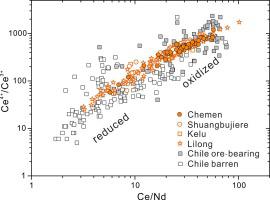Journal of Asian Earth Sciences ( IF 3 ) Pub Date : 2021-05-20 , DOI: 10.1016/j.jseaes.2021.104829 Lipeng Zhang , Yongbin Hu , Jianghong Deng , Jinrong Wang , Kun Wang , Qinglin Sui , Yuxiao Chen , Kai Wu , Weidong Sun

|
Large-scale Late Cretaceous magmatic intrusions have been recognized in the southern Gangdese magmatic belt, although their genesis and mineralization potential remain controversial. In this paper, we present new zircon U-Pb ages, whole-rock compositions, and major- and trace element compositions of zircon and apatite from the Chemen granodioritic intrusion. When integrated with compiled literature data for other Late Cretaceous igneous rocks in the southern Gangdese belt, our new dataset provides new insight into their genesis and mineralization potential. The Chemen intrusion obtains a zircon U–Pb age of ~91 Ma, similar to the age of Late Cretaceous magmatic intrusions across the entire southern Gangdese belt. Both the Chemen and other Late Cretaceous intrusions have geochemical characteristics that resemble those of adakites. When considered alongside the coeval formation of mafic intrusive rocks, high-temperature adakitic charnockites, and thickening of continental crust in the region, ridge subduction is considered most likely to be responsible for this ‘flare-up’ event. The Ce4+/Ce3+ ratios in zircon and SO3 contents of apatite from the Chemen granodiorites both indicate a high oxygen fugacity during crystallization. Further, trace elements in Chemen apatite indicate that the Chemen intrusion has a great mineralization potential; however, no mineralization has been found in some of the Late Cretaceous intrusions in the southern Gangdese belt. Compiled data show that these barren Late Cretaceous intrusions generally formed from magmas with a low oxygen fugacity. Thus, we speculate that the low oxygen fugacity of some Late Cretaceous intrusions may limit the extent to which mineralization may occur.


























 京公网安备 11010802027423号
京公网安备 11010802027423号